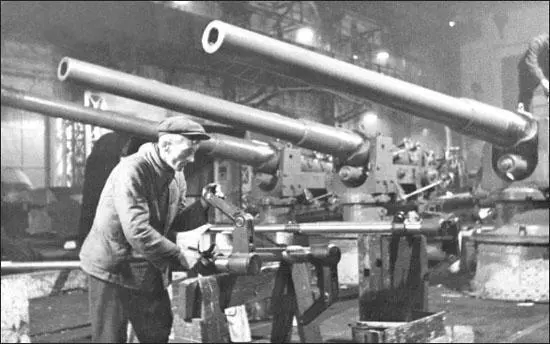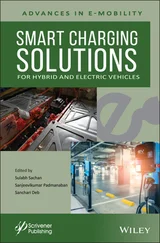I. General characteristics.
1. Vehicle type: tracked, armored
2. Full combat weight with ammunition, fuel, water and crew: not more than 65 tonnes
Shipping weight: not more than 60 tonnes
3. The overall dimensions of the system on a railcar must be limited to 3500 mm in width and 5300 mm in height (from the rails); that is, the vehicle must not exceed the zero-gauge parameters.
4. Speed: 30 km/h maximum.
Maximum gradient on solid ground: 30°
5. Armament:
- BR-2 152 mm gun
- DT machine guns: two
- PPD pistols: two
- Angle of depression of the gun: minus 3°; the machine-gun dead space must not exceed 10 meters.
- Gun elevation angle: +15°
- Gun traverse angle: +/- 4°
Traverse angle:
- Rear machine gun: at least 30°
- Bow machine gun (radio operator): at least 15°
6. Combat load:
- 152 mm projectiles: 47
- Machine-gun cartridges: 3000
- F-1 hand grenades: 30
- PPD cartridges: 1000
7. Mobility:
- Gradient: at least 30°
- Side slope: at least 25°
- Vertical step: at least 0.8 m
- Trench: at least 3.0 m
- Ground pressure: not more than 0.85 kg/cm²
- Ford (unprepared): at least 1.5 m
8. Fuel endurance: at least 10 hours of engine operation
9. Crew: 7
- Provide a capability for the crew to change position inside the vehicle (without exiting it).
- Note: the installation and design of the gun must allow for firing at a 5° angle of depression.
10. Communications equipment:
- For external communications: a shortwave (10R), quartz radio and a set of flags
- For internal communication: an intercom system at four locations (commander, driver, gunner, radio operator)
- Rod antenna
11. Armor protection.
Armor thickness:
1) Glacis: 60 mm
2) Side: 60 mm
3) Lower front plate: 50 mm
4) Lower rear plate: 40 mm
5) Turret: 60 mm
6) Top: 20 mm
7) Bottom: 20 mm
The armor must be sloped at least 10° on the front and sides and -5° on the rear wall.
12. Engine: V-2K turbocharged diesel engine of 700–850 hp
13. Observation and aiming devices.
- In the turret, a PT-1 from the 45 mm tank gun and a KT-1 telescopic sight.
- Mount a cupola for the commander with 360° visibility on the vehicle roof.
- Vision blocks with mirrors may be used.
- Provide the driver-mechanic with a vision block for forward vision and an optical device with a mirror in the vehicle roof for observation to the sides.
- Provide a vision block with a mirror for the radio operator.
- All vision devices must be designed to prevent projectiles, bullets, lead spray, and burning liquid from entering the tank through them.
- Provision must be made for replacing vision devices, their heads and lenses, and the crew must be able to safely clean them from inside the vehicle.
14. Special equipment:
a) The driver’s position must be designed for maximum comfort when driving the vehicle.
b) Locate the instrumentation for easy visibility by the driver and keep it to a minimum.
c) Provide protection for the driver against wind, dust, and rain when driving with the hatch open.
d) Seats must be provided for the entire crew while the vehicle is in motion.
e) Power steering may be installed to facilitate driving.
f) Provide for filtering and heating the air in the fighting and driving compartments.
g) Develop tools for facilitating the mounting of tracks, for removing the main assemblies and armor from the hull, and for self-recovery of the vehicle.
h) Develop a folding tray to facilitate loading. {8} 8 TsAMO RF, collection 81, series 12104, file No. 147, pp. 77–80.

Model of the KV-3 heavy tank. Beginning in the spring of 1941, this tank’s chassis came to be viewed as the base for the 212A SP gun (TsAMO).

B-13 130 mm naval guns undergoing assembly at the Bolshevik Factory. This gun and others with its ballistics were frequently used as armament for SP guns (V. Len).
In addition to SP gun 212, work also continued on a vehicle armed with the B-13 130 mm naval gun. This SP gun, later dubbed the SU-B-13, was first mentioned in a December 26, 1940, letter written by M. M. Zhevannik. Marshal Gregory Kulik also mentioned it in passing in an April 17, 1941, letter to Stalin, and he also discussed a different caliber for a similar SP gun:
Based on our analysis of the penetrability of the armor on Red Army artillery systems and the trends toward increasing armor protection of foreign tanks, I consider it urgent to increase the power of our antitank and tank artillery. To accomplish this, I believe we need to take the following actions:
<���…>
III. Self-propelled guns:
To combat super-heavy tanks and bunkers, we must develop self-propelled guns with the following heavy artillery systems: the BR-2 152 mm gun, the B-13 130 mm gun, and the powerful new 107 mm gun. The BR-2 152 mm gun is capable of defeating 155 mm of armor at a 0° angle of incidence from a range of 2300 meters. The 130 mm gun can penetrate 130 mm of armor at a 0° angle of incidence from a range of 4000 meters, and the new 107 mm gun should penetrate 160 mm of armor at a 30° angle of incidence from a range of 1000 meters.
The 152 mm self-propelled gun has been developed, and a prototype is being manufactured at the Kirov Factory.
An elongated KV-4 tank chassis was used as the base vehicle.
The vehicle with the 152 mm gun weighs 65 tonnes.
The vehicle is equipped with armor 60 mm thick.
Under a February 7, 1941, decree issued by the Council of People’s Commissars of the USSR and Central Committee of the All-Union Communist Party (Bolshevik), the People’s Commissariat of Heavy Machine Building has been tasked with producing 10 vehicles mounting the BR-2 152 mm gun at the Kirov Factory this year.
The People’s Commissariat of Heavy Machine Building must be required to deliver the prototype of this self-propelled gun by June 1, 1941, and manufacture the remaining systems this year.
In addition, the People’s Commissariat of Heavy Machine Building must produce a prototype of the 130 mm self-propelled gun by September 1 and a prototype of the 107 mm self-propelled gun by October 1. The chassis used for the 152 mm system is also being used for these systems. A B-13 130 mm gun has already been delivered to the factory. The People’s Commissariat of Arms must be required to manufacture the new 107 mm gun’s tipping parts at Factory No. 172 and deliver it to the Kirov Factory by June 1941. {9} 9 TsAMO RF, collection 81, series 12104, file No. 147, pp. 195–198.

Ammunition for the M75 107 mm antitank gun (TsAMO).
In the spring of 1941, there were already two promising 107 mm antitank guns. In addition to the ZIS-24, which had been in development since 1940, work began on another gun in the spring of 1941. Its armor-penetration characteristics were as specified in Kulik’s letter. Factory No. 172 (in the city of Molotov, now Perm) was tasked with developing and manufacturing two antitank-gun prototypes. This system was assigned the designation M75. M75 development was headed up by the designer S. N. Dernov, and Factory No. 172’s chief designer, S. P. Gurenko, was responsible for overall management of the project.
Читать дальше















